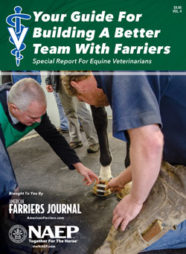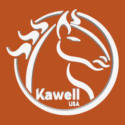2000 Miles
I’m shoeing a horse in Panama on the phone. What? Are you crazy?
Message on my desk: “Urgent! Call. Lame horse. Needs wedge shoes.” Wedge shoes are an immediate red flag to me, but I stifle myself and return the call to Doctor Arauz-Dutari, a dental surgeon in North Carolina.
He has a racehorse in Panama with suspensory problems and has been advised to get wedge shoes. He’s called all over the United States and can’t find them anywhere. He finally called Santa Anita Race Track in California and they said, “Oh, there’s only one person you need to call and that’s Ada Gates. Her number is….”
And so it started. The Dr. sent me photos. Oooohhh, they reveal feet all gone wrong: off level, coronet hair bristling straight up and out, jamming at the heels on both sides, foot displace off center of legs, flares, and pointing to the right front in every shot. It was how the horse came to them from another barn.
 Front feet before trimming and shoeing, look at that coronet on the left front
Front feet before trimming and shoeing, look at that coronet on the left front
I was very clear with the Dr. “We need to get this horse back to Ground Zero, get him flat, level, and balanced with 50% of the mass in front of the center of the hoof and 50% behind. We can achieve that by measuring. I’ll send you this little kit with a ruler and when you go to Panama next week, take it and give it to the farrier. Get the horse, farrier, trainer, and yourself on a speakerphone and I’ll talk you through it, step-by-step.”
Unbeknownst to me, they went through the whole kit the night before: the article, step-by-step instructions, and instructional DVD filmed in Solvang, Calif., with trainer Monty Roberts, farrier Elmer Jones and me. They wanted an idea of what was to come. This was NEW territory but they were willing.
Day Of: I start by assessing the horse BEFORE. You can’t know where you’re going if you don’t know where you’re starting. I point out the uneven coronet that’s not parallel to the ground, the uneven heels that are too high, and the frog that’s not touching the ground. Flares run out one side of the hooves, and there's a broken back angle of pastern to capsule.
“Now look at the head, the neck, the eyes, what are they doing? Head up, ears back, stiff neck. The walk: gait short, body stiff and that telltale glazed look in the eye. He’s not head-bobbing lame but he’s really uncomfortable.
Let’s start on the non-weight bearing right front foot. With your knife, remove all debris at the tip of the frog and the sole around it. Define very accurately where the tip of the frog actively meets the sole. Take a magic marker and mark that exact spot at the tip of the frog. Lay the ruler on the bottom of the foot with that little window over the black mark at the tip of the frog. The ruler will measure three quarters of an inch back from the tip of the frog to indicate the center of the hoof. It shows as “0” on the ruler. Now, holding the ruler in place on the frog, what is the measurement to the outside wall of the toe? “
“2-1/2 inches,” says the farrier.
“Now, keeping the ruler in place, what is the measurement to the heels?”
“One side is 2”, the other side is 1-7/8”.”
Aha! Not only does the heel not match the toe, they don’t even match each other. There is more mass in front of center and much less behind.
 Measuring the foot with the ruler
Measuring the foot with the ruler
“Dust off the bottom of the hoof with your rasp and look at the thickness of the walls. Is one area thicker than the other? That’s a flare. Mark the outside of the hoof right at those flares. They’ve got to go. Bring the foot forward and take down your flares. It’s the first thing you do. Rasping straight down--no dubbing--remove the flares with long, easy, soft, slow strokes. We are not killing snakes here. Now go figure, if you trim the hoof first and then take off the flares, the foot is TOO short. Take the flares off FIRST. Clean up the sole, the sides of the frog and trim the toe where you want it to be. JUST the toe. Replace the ruler back over the black mark on the frog. Remember, that black mark is just the anchor. The ruler is measuring from “zero”, the center of the hoof. Now, what is the toe?”
“2-1/4.”
“Holding the ruler in place, take that magic marker and mark exactly 2-1/4” on each heel. Go to one heel, trim exactly to that mark, trimming down to meet the toe. Go to the other heel and trim exactly to that mark, trimming down to meet the toe. Take your rasp and dust off the bottom to smooth it up. You now have a perfectly balanced, flat, and level foot with 50% of mass in front of center, 50% behind. A teeter totter, the balance of a seesaw.
 Owner: Dr. Jose I. Arauz-Dutari, DMD Diplomate of The American Board of Periodontology
Owner: Dr. Jose I. Arauz-Dutari, DMD Diplomate of The American Board of Periodontology
STOP. When you put the foot down, don’t look at the foot, look at the horse. He’ll drop his head, his ears will go forward, his neck will relax, his eyes will soften, he may let out a gush of air and he’ll start licking and chewing. Are you ready? Drop the foot and look at the horse.”
There is a long silence on the phone. Then I heard them yelling,
“Oh my God, my horse, my horse! Look at him; I’ve never seen him so relaxed! He’s doing everything you said. He’s licking and chewing, his head is at the ground. He even let out a huge gush of air! If only you could see him!”
I reply quietly, “I already can. I see him in my heart’s eye. Now let him rest a bit and let’s do the exact same process on the left front.”
We finished. The left foot was dropped down, the head dropped even lower and the licking and chewing started immediately. The horse walked away, then back to us, his whole body undulating in a rhythmic sway, his head down, ears forward, striding way out, arriving back to us, licking and chewing again. This was one happy, relaxed, and comfortable horse and he was saying, “Thank you, thank you” with every fiber of his body.
“If you can read a horse, you see a wealth of expression you could never imagine.” Monty Roberts taught me that. He taught me to recognize the horse’s language. I could never have done this without him. Hats off to the farrier in Panama, Alexi. He’d never done this before but he didn’t resist. He fell in and did a whole new process practically blind, on the phone, and did a great job. And hats off to the owner, Dr. Jose Arauz-Dutari who’s been the driving force from the beginning.
 Farrier Alexis Vásquez uses a St. Croix aluminum race plate for a perfect fit.
Farrier Alexis Vásquez uses a St. Croix aluminum race plate for a perfect fit.
Almost two hours had passed. I told them to put him up, that was enough for him today. “Let him rest, do the hind the exact same way tomorrow or the next day. We’ll redo the front for sure in twenty-one days. Not twenty or twenty-two. That’s just the right amount of growth and body adjustment to redo the same balance exactly right so the feet don’t get away from us again. With his suspensory issues just let him rest and rest, light hand walking, very quiet. Oh, and send me pictures of the finished job nailed up.”
Well, it wasn’t more than a week when they called to tell me the groom couldn’t handle him on the ground anymore. He was so strong and eagerly moving forward, that they had to pony him with another horse. Another week or two, they called again. Now he’s at the track with the rider at the trot.
At twenty-one days, we do the whole process all over again. The team in Panama is in place, the owner, Dr. Arauz-Dutari is now back in North Carolina but he’s on two phones, one to me, one to them, translating everything I’m saying. More time passes—a week or two—and now he’s galloping. The horse is floating over the track and starting to look like the racehorse he really is.
 Hipódromo Presidente Remón (Est. 1956). Our horse in an early morning gallop
Hipódromo Presidente Remón (Est. 1956). Our horse in an early morning gallop
The team wants to start feeding Farrier’s Formula from Life Data Labs. The feet are ratty, soft, thin-walled, not growing. Farrier’s Formula addresses all this and grows a strong, hard, healthy hoof. There could easily be major issues with exporting goods into Panama: will it get through customs, this consumed supplement? It flies through.
So who’s been in charge of all this? Why could the doctor not find the wrong shoes? How did he call 3000 miles away to Santa Anita and get patched through to me? How is it after a long conversation about a difficult decision, the owner saw a sticker on the car in front of him: "Proverbs 3:5-6, Trust in the Lord with all your heart and lean not on your own understanding; in all your ways submit to him, and he will make your paths straight.” Over and over again, down to the tiniest square minute, everything has been right: the farrier, the trainer, the owner and most of all, the horse. The horse is right. They always are. They only know how to speak the truth. Who knows what he’ll do? He’s bred to do a lot. Let’s watch and see.
 The team in Panama ... Trainer Juan Paulo Céspedes (left), Farrier Alexis Vásquez (right), and 3-year-old Thoroughbred stallion Uncle Chief
The team in Panama ... Trainer Juan Paulo Céspedes (left), Farrier Alexis Vásquez (right), and 3-year-old Thoroughbred stallion Uncle Chief







